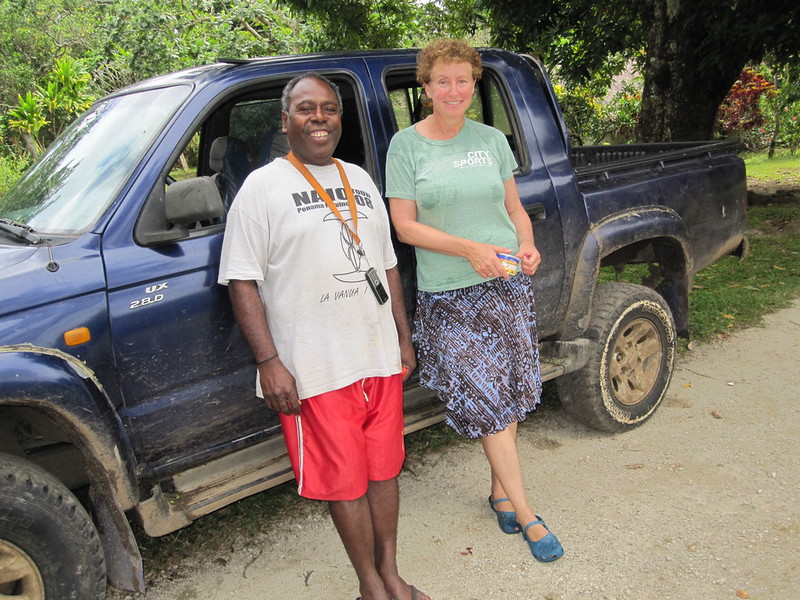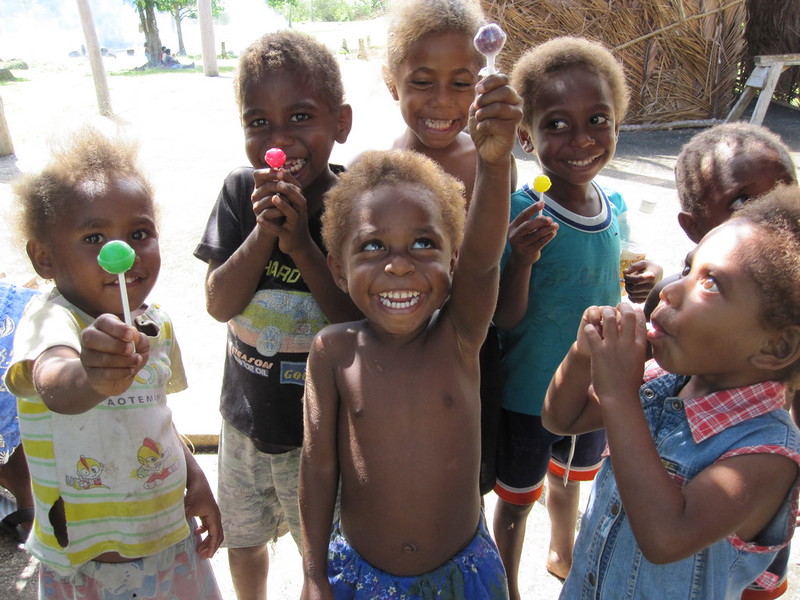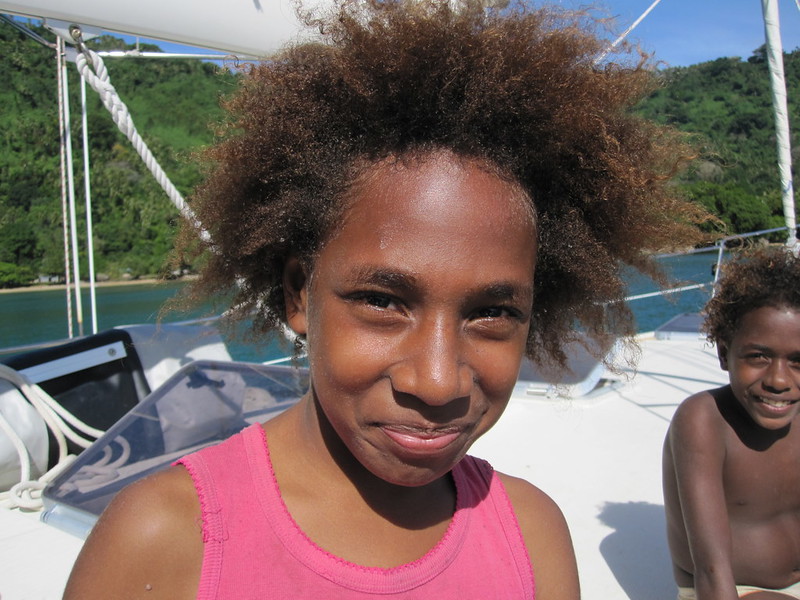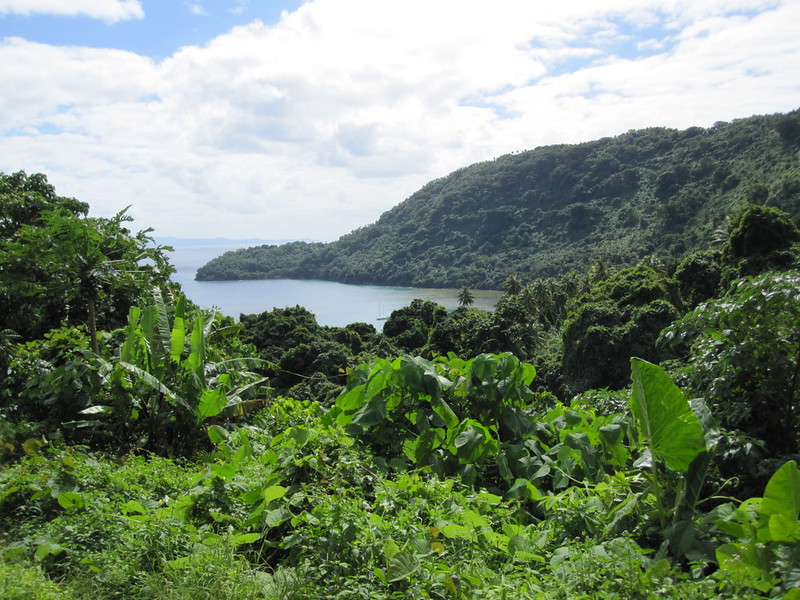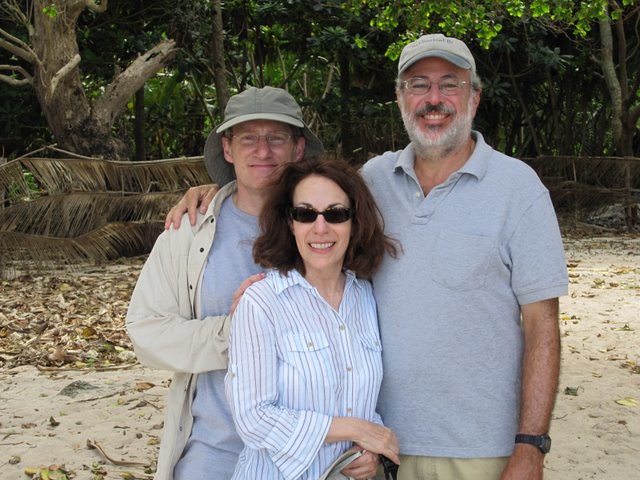July 16, 2010
Yesterday there was a wedding in Loltong to which we were invited. Two important families from two different “tribes”, one from Loltong and one from the east coast of Pentecost Island, were joined. The festivities began even before we arrived and are still on-going. People came from villages all over north Pentecost. The bride received a very large pile of goods from the groom’s family, including a large sack of rice, clothing, bedding, a TV, and boxes filled with stuff. The groom received 13 pigs and 40,000 vatu in cash. The cash was in a sealed envelope on a post next to the largest pig — a highly desirable pig with tusks that had curved back into a complete circle.
The ceremony was in the church with a male choir singing beautifully. The church is simple, lacking both pews and glass in the windows. The bride wore a simple white gown and there were bridesmaids. The groom showed no emotion, even during the receiving line when family and friends came to wish the new couple well, and slap the bride and groom with talcum powder. I took a video of the event that came out great, and took still photos of the couple outside the church. Laura and I were the only foreigners at the event.
After the ceremony, the bride disappeared and we have not seen her since. She stays out of sight with family. The festivities go on without her. In front of the nakamal (the men’s clubhouse where kava is drunk), where the pigs are tied up, the heads of both families gave speeches, as did the paramount chief (Chief William). Then the brides extended family, about 20 men and women, walk in circles around the groom, who stands next to the largest pig and the post with the cash, and a dozen specially woven pandamus mats, inspecting the goods. They make five complete circles, while the groom just looks at the ground distractedly, touching the mats and the envelope with cash. Then the mats at folded up and go to the bride’s family, and the pigs are led away for the groom’s family. Everyone is dressed simply, with the chief of the bride’s village wearing a sweater with “Polo Ralph Lauren” emblazoned in large letters across his chest.
At this point, the drinking of kava, which has been going on for at least a day prior to the wedding, began in earnest — but only for the men. There is a “wedding nakamal” set up across from the regular village nakamal, with enormous quantities of freshly prepared kava, and piles of kava root yet to be prepared. It is reminiscent of an open bar at a wedding in the West. I had only one cup of kava as a way of saying “mazel tov” to the newly married couple. Men kept cycling through the nakamal to get another half-coconut shell filled with the strong, pungent kava of Pentecost Island.
It became quite dark, so Laura and I left to return to the boat. All through the night, the men continued to drink kava, and to sing and dance. Their songs were more like chants performed by a chorale, with the effect heightened by the steep cliffs above the village. We printed some wedding photos for the bride and groom on the boat, and returned to the village in the morning to leave them with family. In the morning, men were lying and sitting around the wedding nakamal, still under influence of kava, and we were surprised to see the groom sitting among them, somewhat zoned out, so we gave the photos directly to him.
We proceeded through the village to the home of Dickie and Eva, a couple we had befriended last year when we were in Loltong with Hannah. Dickie is a body builder and was an amateur and professional boxer, having traveled around the South Pacific for bouts. We brought them a big bag of gifts plus photos of them and their children that we took last year. They gave us a big load of fruit and drinking coconuts. We also met with Dickie father Jeffrey, who we also know from last year. Jeffrey’s father (Dickie’s grandfather) migrated to Espritu Santo Island in 1942 to work as a laborer for the US Navy, building the large naval facility and air base that turned into modern day Luganville. It was apparently a life changing event for the family, and the grandfather had only the highest regard to the Americans.
Dickie led us up a rather steep (for us) path along the cliff to Vulumanu College, a secondary boarding school. At the wedding, we had befriended Frazier, an extremely knowledgable and articulate teacher at the school. Frazier had worked in the Ministry of Foreign Affairs in Port Vila for some years, and accompanied the first Prime Minister (Walter Lini, from Pentecost) to the United Nations in the late 1980’s. Vulumanu College has 107 students in grades 9 through 13, who come from Pentecost and nearby islands. Vulumanu refers to the creation myth of Pentecost. Vulumanu was a giant bird (dragon) that lived on the precipice at the far north of the island and ate every person who dared to live on Pentecost Island. Finally, a woman arrived and bore two childen who slew Vulumanu, enabling the island to be populated. Something like that. We toured the school and met the principal, Reginald, who urged our return so that I could talk to the students about economics. On the way back down to Loltong, Dickie suddenly stopped and asked me if he could ask a question. He asked: Are there are still dragons alive in the world?
We were pretty tired when we returned to the boat in the afternoon, and had no further plans for the day. As we lay resting in the forward berth, we heard the squeals and laughter of small children. We had become friends with the little children who play under the banyan tree on the beach, giving them all lollipops and letting them help push our dinghy in the water. Perhaps this was their laughter? But our boat was anchored at least 1/4 mile from the beach — too far to hear children. I stuck my head out of the companionway to see if there was a boat nearby and saw nothing, and went back below. Then we heard more laughter, and much to our surprise, a gaggle of eight small children were treading water against our hull. They were the beach children, who swam out for a visit all by themselves. The youngest were six years old and naked, the oldest wore underpants and were no more than 11. They were shivering and tired. We put our boat ladder in the water and had them come aboard to rest, warm up, and eat cookies. When it was time to leave they just jumped off the back of the boat and started dog paddling to shore. We worried about the little ones, so we followed in the dinghy. I guess we should not have worried – we have seen six year old children walking around with machetes bigger than they.
We made one last trip to shore at sunset. Men were sprawled around the wedding nakamal, enjoyed their kava high. Us two gringos have quickly become familiar sights in Loltong, and we got only small friendly waves from the men — the groom still among them.
M.
Posted via email from sabbatical3blog’s posterous







